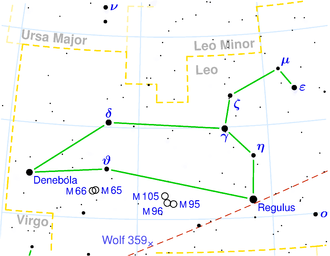NGC 3926
| Galaxie NGC 3926 | |
|---|---|
 | |
| SDSS-Aufnahme | |
| AladinLite | |
| Sternbild | Löwe |
| Position Äquinoktium: J2000.0, Epoche: J2000.0 | |
| Rektaszension | 11h 51m 28,2s[1] |
| Deklination | +22° 01′ 33″[1] |
| Erscheinungsbild | |
| Morphologischer Typ | 1/2: E / PAS[1][2] |
| Helligkeit (visuell) | 1: 14,5 mag 2: 14,7 mag[2] |
| Helligkeit (B-Band) | 2: 15,5 mag 2: 15,7 mag[2] |
| Winkelausdehnung | 1: 0.5/0.4 2:0.9 / 0.9[2] |
| Positionswinkel | 1: 117°[2] |
| Flächenhelligkeit | 1: 12,8 mag/arcmin² 2: 14,5 mag/arcmin²[2] |
| Physikalische Daten | |
| Rotverschiebung | 0.028343 ± 0.000070[1] |
| Radialgeschwindigkeit | 8497 ± 21 km/s[1] |
| Hubbledistanz vrad / H0 | (378 ± 26) · 106 Lj (115,9 ± 8,1) Mpc [1] |
| Geschichte | |
| Entdeckung | Wilhelm Herschel |
| Entdeckungsdatum | 26. April 1785 |
| Katalogbezeichnungen | |
| NGC 3926 • UGC 6829 • PGC 37079/37080 • CGCG 127-076 • MCG +04-28-074/073 • VV 218 • GC 2589 • H III 379 • h 998 • | |
NGC 3926 ist ein Galaxienpaar, beides elliptische Galaxien vom Hubble-Typ E-S0, im Sternbild Löwe, das schätzungsweise 360 Millionen Lichtjahre von der Milchstraße entfernt ist.
Die Galaxie wurde am 26. April 1785 von dem Astronomen Wilhelm Herschel mit seinem 18,7-Zoll-Spiegelteleskop entdeckt.[3]
Weblinks
Einzelnachweise
Auf dieser Seite verwendete Medien
Autor/Urheber: Copyright © 2003 Torsten Bronger., Lizenz: CC BY-SA 3.0
This is a celestial map of the constellation Leo, the Lion.
Autor/Urheber: Sloan Digital Sky Survey, Lizenz: CC BY 4.0
The sky image is obtained by Sloan Digital Sky Survey, DR14 with SciServer.
Angle of view: 4' × 4' (0.3" per pixel), north is up.
Details on the image processing pipeline: https://www.sdss.org/dr14/imaging/jpg-images-on-skyserver/



